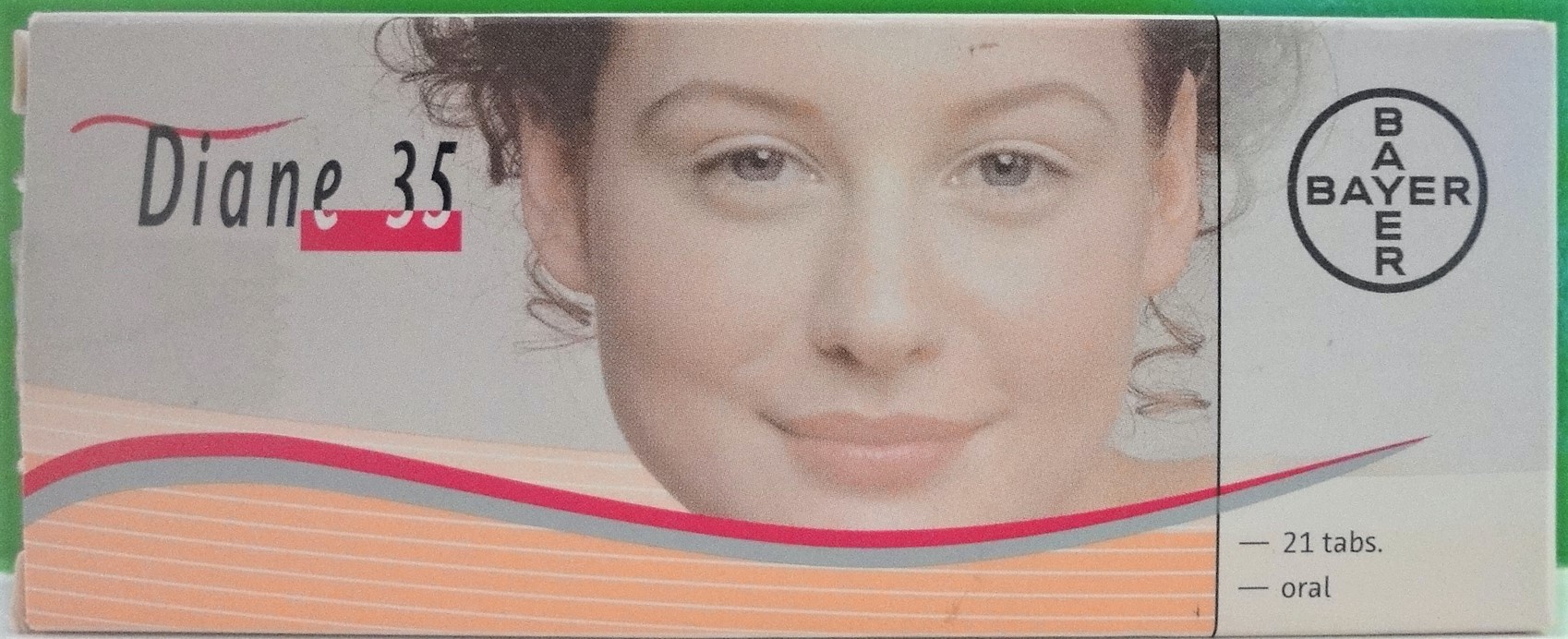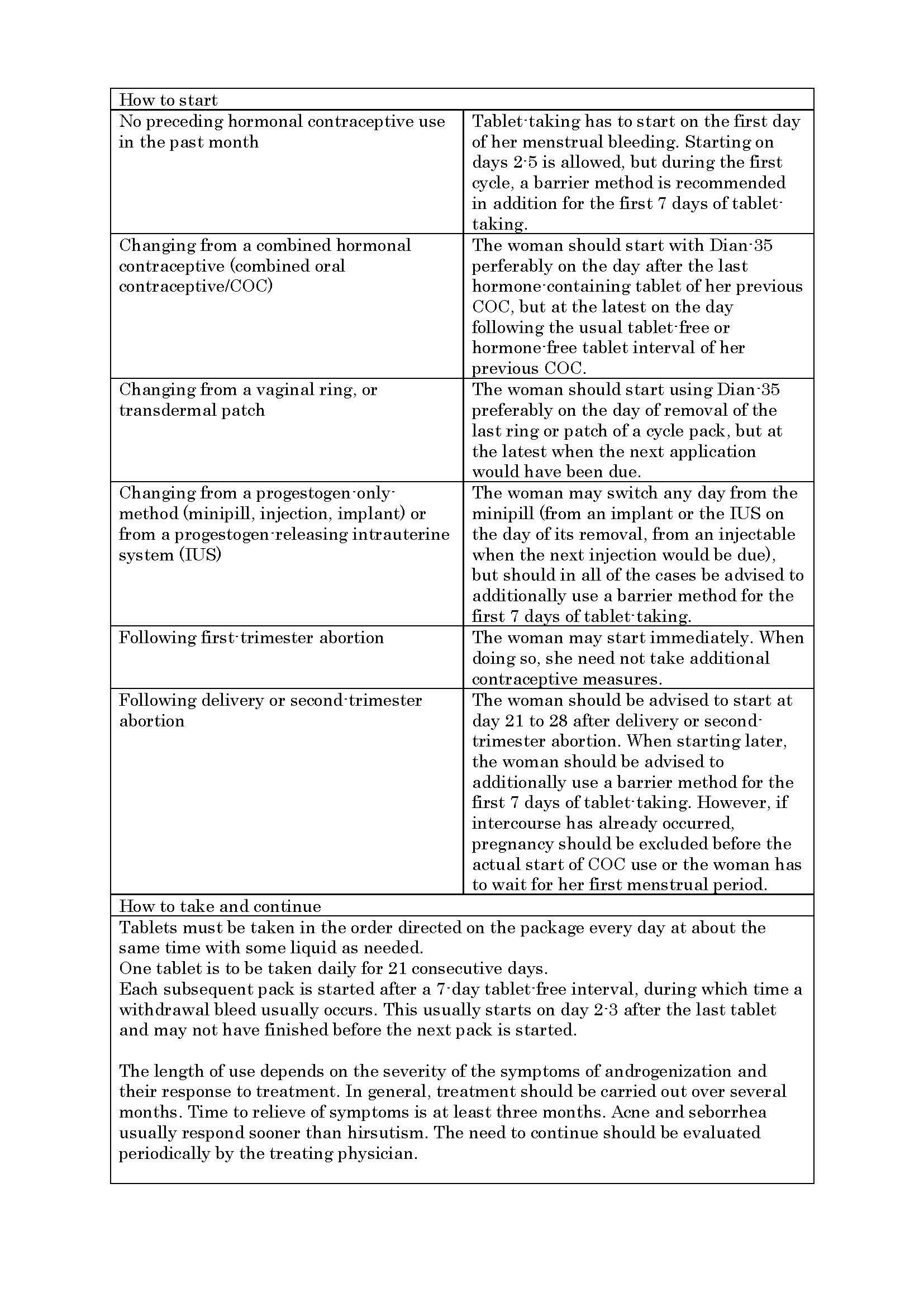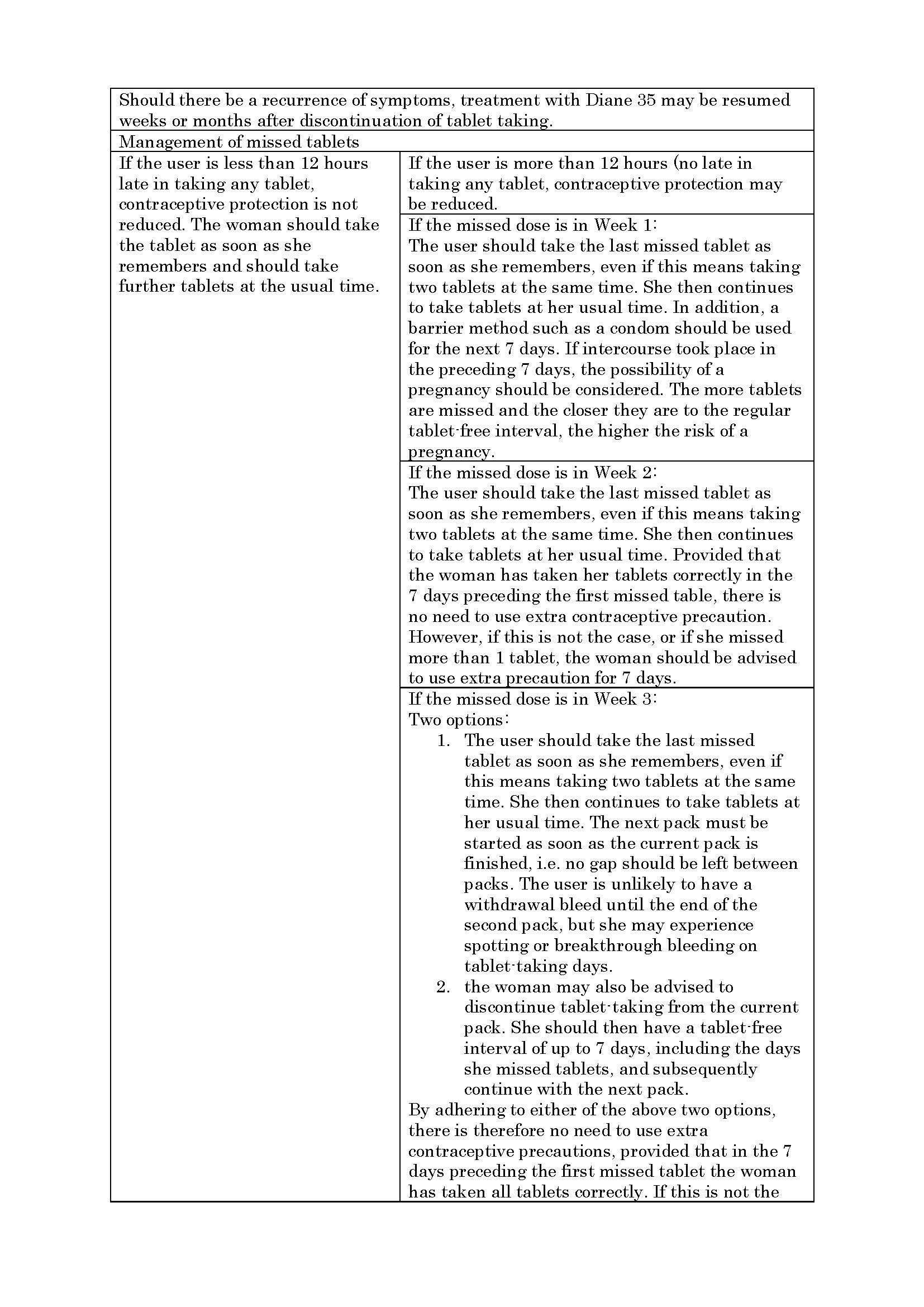DIANE-35 Tablet
ក្រុមហ៊ុនផលិតឱសថ:
Bayer Weimar GmbH und Co. KG, Germany
ក្រុមហ៊ុនចែកចាយឱសថនៅប្រទេសកម្ពុជា:
DKSH


- សារធាតុសកម្ម
- ប្រសិទ្ធិភាពព្យាបាល និង កម្រិតប្រើប្រាស់
- ហាមប្រើ
- ផលរំខាន
- អន្តរប្រតិកម្ម
- ស្ត្រីមានផ្ទៃពោះ និង ស្ត្រីបំបៅដោះកូន
- ការប្រុងប្រយ័ត្នជាពិសេស
- សកម្មភាពឱសថ បរិយាយប័ណ្ណឱសថ
-
សារធាតុសកម្ម
Cyproterone acetate 2mg, Ethinylestradiol 0.035mg
-
ប្រសិទ្ធិភាពព្យាបាល និង កម្រិតប្រើប្រាស់



-
ហាមប្រើ
ហាមប្រើ:
- ចំពោះអ្នកធ្លាប់មានប្រវត្តិឈាមកក ឬ ឈាមខាប់ ស្ទះក្នុងសរសៃឈាម និងគ្រោះថ្នាក់ សរសៃឈាម ចិញ្ចឹមខួរក្បាល
- ចំពោះអ្នកធ្លាប់មានជម្ងឺវិបត្តិឈាមកក ចុកទ្រូង
- ចំពោះអ្នកជម្ងឺប្រកាំង (migrain)
- ចំពោះអ្នកជម្ងឺទឹកនោមផ្អែម
- ចំពោះអ្នកជម្ងឺរលាកលំពែង
- ចំពោះអ្នកជម្ងឺថ្លើម ឬ ខ្សោយតួនាទីថ្លើម
- ចំពោះអ្នកជម្ងឺថ្លើមក្រិន
- ចំពោះអ្នកធ្លាប់មានវិបត្តិផ្លូវភេទ
- ស្ត្រីមានផ្ទៃពោះ និង កំពុងបំបៅកូន
- អ្នកងាយមានប្រតិកម្មជាមួយសារធាតុផ្សំណាមួយនៃឱសថនេះ
- ចំពោះមនុស្សប្រុស
- មានការហូរឈាមតាមទ្វារមាសPresence or a history of venous or arterial thrombotic/thromboembolic events (e.g. deep venous thrombosis, pulmonary embolism, myocardial infarction) or of a cerebrovascular accident.
- Presence or history of prodromi of a thrombosis (e.g. transient ischaemic attack, angina pectoris)
- A high risk of venous or arterial thrombosis
- History of migraine with focal neurological symptoms
- Diabetes melitus with vascular symptoms
- Severe hepatic disease
- Presence or history of liver tumours (benign or malignant)
- Known or suspected sex-steroid influenced malignancies (e.g. of the genital organs or the breasts)
- Undiagnosed vaginal bleeding
- Concomitan use with another hormonal contraceptive
- Known or suspected pregnancy
- Lactation
- Hypersensitivity to the active substances or to any of the excipients
-
ផលរំខាន
ផលរំខាន: </strong>
- ការប្រើឱសថនេះអាចបណ្ដាលអោយសម្ពាធឈាមឡើង
- ការប្រើឱសថនេះលើសកំរិតបណ្ដាលអោយ:
+ ចង្អោរ ក្អួត
+ ចំពោះស្ត្រីក្មេងអាចអោយហូរឈាមតាមប្រដាប់ភេទ
+ ចំពោះករណីនេះ ត្រូវបញ្ឈប់ការប្រើនិងព្យាបាលរោគសញ្ញាដែលកើតឡើង។
Common adverse reactions: nausea, breast pain, weight increased, headache, depression,
Serious adverse reactions:
- Symptoms of pulmonary embolism: Sudden onset of unexplained shortness of breath or rapid breathing; sudden coughing which may bring up blood; sharp chest pain which may increase with deep breathing; sense of anxiety; severe light headedness or dizziness; rapid or irregular heartbeat.
- Symptoms of a cerebrovascular accident: sudden numbness or weakness of the face, arm or leg, especially on one side of the body; sudden confusion, trouble speaking or understanding; sudden trouble seeing in one or both eyes; sudden trouble walking, dizziness, loss of balance or coordination; sudden, severe or prolonged headache with no known cause; loss of conciousness
- Symptoms of vascular occlusion: sudden pain, swelling and slight blue discoloration of an extremity; acute abdomen.
- Symptoms of MI: pain, discomfort, pressure, heaviness, sensation of squeezing or fullness in the chest, arm or below the breastbone; discomfort radiating to the back, jaw, throat, arm, stomach; fullness, indigestion or choking feeling; sweating, nausea, vomiting or dizziness; extreme weakness, anxiety, or shortness of breath; rapid or irregular heartbeats.
- Symptoms of liver tumors: severe upper abdominal pain, liver enlargement or signs of intra-abdominal hemorrhage.
- Crohn’s disease and ulcerative colitis
- Chloasma
-
អន្តរប្រតិកម្ម
អន្តរកម្មឱសថ:
- ប្រតិកម្មរវាងឱសថនេះនិងឱសថផ្សេងទៀត: ការប្រើឱសថនេះជាមួយពួកឱសថផ្សេងទៀត ដូចជា : phenytoine, barbiturates, primidone, carbamazepine, refampicine, oxcarbazepine, topiramate felbamate, ritonavir, griseofulvin អាចបណ្ដាលអោយមានវិបត្តិមេតាបូលីសនៃថ្លើម
- ការប្រើឱសថនេះជាមួយ penicillin tetracycline បណ្ដាលអោយថយចុះនូវកំហាប់ ethinyl estradiol។Phenytoin, barbiturates, primidone, carbamazepine, rifampicin, and possibly also oxcarbazepine, topiramate, felbamate, griseofulvin and products containing St. John’s wort, many HIV/HCV protease inhibitors and non-nucleoside reverse transcriptase inhibitors
-
ស្ត្រីមានផ្ទៃពោះ និង ស្ត្រីបំបៅដោះកូន
ហាមប្រើចំពោះស្ត្រីមានផ្ទៃពោះ និង កំពុងបំបៅកូន។
-
ការប្រុងប្រយ័ត្នជាពិសេស
ការប្រុងប្រយ័ត្ន:
- អ្នកមានវិបត្តិចរន្តឈាម (thrombotic and thromboembolic diseases)
- អ្នកមានជម្ងឺថ្លើមក្រិន
- ចំពោះស្ត្រីឬគ្រួសារ ដែលមានជាតិខ្លាញ់ក្នុងឈាមខ្ពស់ អាចនាំអោយកើនឡើងនូវជម្ងឺរលាកលំពែង
- ការប្រើឱសថនេះអាចបណ្ដាលអោយសម្ពាធឈាមឡើង
- ប្រតិកម្មរវាងឱសថនេះនិងឱសថផ្សេងទៀត: ការប្រើឱសថនេះជាមួយពួកឱសថផ្សេងទៀត ដូចជា : phenytoine, barbiturates, primidone, carbamazepine, refampicine, oxcarbazepine, topiramate felbamate, ritonavir, griseofulvin អាចបណ្ដាលអោយមានវិបត្តិមេតាបូលីសនៃថ្លើម
- ការប្រើឱសថនេះជាមួយ penicillin tetracycline បណ្ដាលអោយថយចុះនូវកំហាប់ ethinyl estradiol។
- ការប្រើឱសថនេះលើសកំរិតបណ្ដាលអោយ:
+ ចង្អោរ ក្អួត
+ ចំពោះស្ត្រីក្មេងអាចអោយហូរឈាមតាមប្រដាប់ភេទ
+ ចំពោះករណីនេះ ត្រូវបញ្ឈប់ការប្រើនិងព្យាបាលរោគសញ្ញាដែលកើតឡើង។Circulatory Disorders
Epidemiological studies have suggested an association between the use of COCs and an increased risk of arterial and venous thrombotic and thromboembolic diseases such as myocardial infarction, deep venous thrombosis, pulmonary embolism and of cerebrovascular accidents. These events occur rarely.
The risk of VTE is highest during the first year of use. This increased risk is present after initially starting a COC or restarting (following a 4 week or greater pill free interval) the same or a different COC. Data from a large prospective 3-armed cohort study suggest that this increased risk is mainly present during the first 3 months. (See the package insert for details.)
Other medical conditions which have been associated with adverse circulatory events include diabetes mellitus, systemic lupus erythematosus, hemolytic uremic syndrome, chronic inflammatory bowel disease (Crohn's disease or ulcerative colitis) and sickle cell disease.
An increase in frequency or severity of migraine during Diane-35 use (which may be prodromal of a cerebrovascular event) may be a reason for immediate discontinuation of Diane-35.
Biochemical factors that may be indicative of hereditary or acquired predisposition for venous or arterial thrombosis include Activated Protein C (APC) resistance, hyperhomocysteinemia, antithrombin-Ⅲ deficiency, protein C deficiency, protein S deficiency, antiphospholipid antibodies (aticardiolipin antibodies, lupus anticoagulant).
Tumors
The most important risk factor for cervical cancer is persistent HPV infection. Some epidemiological studies have indicated that long-term use of COCs may further contribute to this increased risk but there continues to be controversy about the extent to which this finding is attributable to confounding effects, e.g., cervical screening and sexual behavior including use of barrier contraceptives. (See the package insert for details.)
In rare cases, benign liver tumors, and even more rarely, malignant liver tumors have been reported in users of COCs. In isolated cases, these tumors have led to life-threatening intra-abdominal hemorrhages. A liver tumor should be considered in the differential diagnosis when severe upper abdominal pain, liver enlargement or signs of intra-abdominal hemorrhage occur in women taking COCs.
Malignancies may be life-threatening or may have a fatal outcome.
Other conditions
Women with hypertriglyceridemia, or a family history thereof, may be at an increased risk of pancreatitis when using COCs.
Although small increases in blood pressure have been reported in many women taking COCs, clinically relevant increases are rare. (See the package insert for details.)
The following conditions have been reported to occur or deteriorate with both pregnancy and COC use, but the evidence of an association with COC use is inconclusive: jaundice and/or pruritus related to cholestasis; gallstone formation; porphyria; systemic lupus erythematosus; hemolytic uremic syndrome; Sydenham's chorea; herpes gestations; otosclerosis-related hearing loss.
In women with hereditary angioedema exogenous estrogens may induce or exacerbate symptoms of angioedema.
Acute or chronic disturbances of liver function may necessitate the discontinuation of COC use until markers of liver function return to normal. Recurrence of cholestatic jaundice which occurred first during pregnancy or previous use of sex steroids necessitates the discontinuation of COCs.
Diabetic women should be carefully observed while taking COCs. (See the package insert for details.)
Crohn's disease and ulcerative colitis have been associated with COC use.
Chloasma may occasionally occur, especially in women with a history of chloasma gravidarum. Women with a tendency to chloasma should avoid exposure to the sun or ultraviolet radiation whilst taking COCs.
Reduced cycle control
With estrogen/progestogen combinations, irregular bleeding (spotting or breakthrough bleeding) may occur, especially during the first months of use. (See the package insert for details.)
-
សកម្មភាពឱសថ
Cyproterone acetate is a competitive antagonist on the androgen receptor, has inhibitory effects on the androgen-synthesis in target cellls and produces a decrease of the androgen through an antigonadotropic effect. This antigonadotropic effect is amplified by ethinylestradiol which up-regulates as well the synthesis of Sexual-Hormone-Binding-Globulin (SHBG) in plasma. It thereby reduces free, biologically available androgen in the circulation.
*ព័ត៌មានឱសថត្រូវបានរៀបរៀងដោយ អ៊ីម៉ាតុគឹ មេឌីក (ខេមបូឌា) ដោយផ្អែកលើប្រភពព័ត៌មានខាងក្រោម។ សម្រាប់ព័ត៌មានលម្អិត សូមស្វែងរកនៅក្នុងក្រដាសព័ត៌មាននៃឱសថនីមួយៗ ឬ សាកសួរទៅកាន់ក្រុមហ៊ុនឱសថឬតំណាងចែកចាយនៃឱសថនីមួយៗ។
ប្រភពព័ត៌មាន៖
- ក្រដាសព័ត៌មាននៃឱសថសម្រាប់អ្នកជំនាញវេជ្ជសាស្ត្រដែលប្រើប្រាស់នៅប្រទេសជប៉ុន (Pharmaceutical and Medical Devices Agency, Pmda): https://www.pmda.go.jp
- ព័ត៌មានសង្ខេបនៃឱសថសម្រាប់អ្នកជំងឺដែលប្រើប្រាស់នៅប្រទេសជប៉ុន: http://www.rad-ar.or.jp
